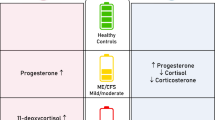Abstract
The value of biomarkers in aiding early diagnosis of disease and predicting response to pharmacologic interventions is well known. The idea that biomarkers may also be used to identify and quantify pain has been investigated in preclinical and clinical studies. Findings from a preclinical study show that inflammatory pain and neuropathic pain have different biomarkers. Further investigations provided mixed results, on the one hand, cystatin C levels in cerebrospinal fluid appear to be a predictive marker for postherpetic neuralgia in patients with varicella-zoster virus, and a pain marker in women experiencing labour pain, but is not correlated with pain duration or intensity. Investigations into potential biomarkers for chest pain showed that cardiac markers used to aid in diagnosis and prognosis of cardiac disease correlate with tissue damage rather than with pain. Further studies are needed to gain insights into biomarkers for pain to enhance pain management practices.

Similar content being viewed by others
References
Biomarkers Definition Working Group-Bethesda Md. Biomarkers and surrogate endpoints: Preferred definitions and conceptual framework. Clin Pharmacol Ther 2001; 69: 89–95
Kalso E. Biomarkers for pain [editorial]. Pain 2004; 107: 199–201
Xiao Z, Prieto D, Conrads TP, et al. Proteomic patterns: their potential for disease diagnosis. Mol Cell End 2005; 230: 95–106
Gineste C, Ho L, Pompl P, et al. High-throughput proteomics and protein biomarker discovery in an experimental model of inflammatory hyperalgesia: effects of nimesulide. Drugs 2003; 63: 23–9
Cornefjord M, Nyberg F, Rosengren L, et al. Cerebrospinal fluid biomarkers in experimental spinal nerve root injury. Spine 2004; 29: 1862–8
Empl M, Renaud S, Erne B, et al. TNFα expression in painful and nonpainful neuropathies. Neurology 2001; 56: 1371–7
Sorkin LS, Xiao WH, Wagner R, et al. TNF-α induces ectopic activity in nociceptive primary afferent fibres. Neuroscience 1997; 81: 255–62
Uceyler N, Rogausch J, Toyka KV, et al. Differential expression of cytokines in painful and painless afferent neuropathies. Neurology 2007; 69: 42–9
Raffaeli W, Samolsky BG, Landuzzi D, et al. Nociceptin levels in the CSF of chronic pain patients with or without intrathecal administration of morphine. J Pain Symptom Manage 2006; 32: 372–7
Brisby H, Olmarker K, Rosengren L, et al. Markers of nerve injury in the CSF in patients with lumbar disc herniation and sciatica. Spine 1999; 24: 742–6
Brisby H, Olmarker K, Larsson K, et al. Proinflammatory cytokines in cerebrospinal fluid and serum in patients with disc herniation and sciatica. Eur Spine J 2002; 11: 62–6
Kuiper JI, Verbeek JH. Exploration of the use of biomarkers to monitor recovery after surgery for lumbar disc herniation: a prospective cohort study. J Spinal Disord 2002; 15: 398–403
Zak-Prelich M, McKenzie RC, Sysa-Jedrzejowska A, et al. Local immune responses and systemic cytokine responses in zoster: relationship to the development of postherpetic neuralgia. Clin Exp Immunol, 2003; 131: 318–23
Kotani N, Kudo R, Sakurai Y, et al. Cerebrospinal fluid interleukin 8 concentrations and the subsequent development of postherpetic neuralgia. Am J Med 2004; 116: 318–24
Mannes AJ, Martin BM, Yang HYT, et al. Cystatin C as a cerebrospinal fluid biomarker for pain in humans. Pain 2003; 102: 251–6
Eisenach JC, Thomas JA, Rauck RL, et al. Cystatin C in cerebrospinal fluid is not a diagnostic test for pain in humans. Pain 2004; 107: 207–12
Jaffe AS. Use of biomarkers in the emergency department and chest pain unit. Cardiol Clin 2005; 23: 453–65
Januzzi JL, Martinez A. Cardiac biomarker testing for chest pain evaluation: where are we heading? Emerg Med Crit Care Rev 2006, 25–7
Acknowledgements
English language assistance for the preparation of this manuscript was provided by Stephanie Blick, Wolters Kluwer Health Medical Communications. This assistance was funded by Molteni Farmaceutici, Inc. The authors have no conflicts of interest, actual or potential, to report.
Author information
Authors and Affiliations
Corresponding author
Rights and permissions
About this article
Cite this article
Marchi, A., Vellucci, R., Mameli, S. et al. Pain Biomarkers. Clin. Drug Investig. 29 (Suppl 1), 41–46 (2009). https://doi.org/10.2165/0044011-200929001-00006
Published:
Issue Date:
DOI: https://doi.org/10.2165/0044011-200929001-00006




